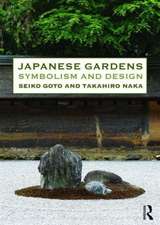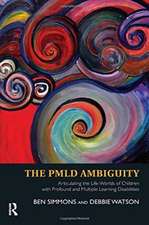Japanese Architecture: An Exploration of Elements & Forms
Autor Mira Locher Fotografii de Ben Simmons Cuvânt înainte de Kengo Kumaen Limba Engleză Paperback – 17 mar 2015
Thick thatched roofs and rough mud plaster walls. An intricate carved wood transom and a precisely woven tatami mat—each element of traditional Japanese architecture tells a story.
In Japanese Architecture, author Mira Locher explores how each of these stories encompasses the particular development, construction, function and symbolism inherent in historic architectural elements. From roofs, walls and floors to door pulls and kettle hangers, Japanese Architecture situates these elements firmly within the natural environment and traditional Japanese culture.
Japanese architecture developed with influences from abroad and particular socio-political situations at home. The resulting forms and construction materials—soaring roofs with long eaves, heavy timber structures of stout columns supporting thick beams, mud plaster walls flecked with straw and sand and the refined paper-covered lattice shoji screen—are recognizable as being of distinctly Japanese design. Designed with strong connections to the surrounding environment, these constructed forms utilize natural construction materials in ways that are both practical and inventive.
This fascinating architecture book provides a comprehensive perspective of traditional Japanese architecture, relating the historical development and context of buildings and the Japanese garden, while examining the stories of the individual architectural elements, from foundation to roof.
In Japanese Architecture, author Mira Locher explores how each of these stories encompasses the particular development, construction, function and symbolism inherent in historic architectural elements. From roofs, walls and floors to door pulls and kettle hangers, Japanese Architecture situates these elements firmly within the natural environment and traditional Japanese culture.
Japanese architecture developed with influences from abroad and particular socio-political situations at home. The resulting forms and construction materials—soaring roofs with long eaves, heavy timber structures of stout columns supporting thick beams, mud plaster walls flecked with straw and sand and the refined paper-covered lattice shoji screen—are recognizable as being of distinctly Japanese design. Designed with strong connections to the surrounding environment, these constructed forms utilize natural construction materials in ways that are both practical and inventive.
This fascinating architecture book provides a comprehensive perspective of traditional Japanese architecture, relating the historical development and context of buildings and the Japanese garden, while examining the stories of the individual architectural elements, from foundation to roof.
Preț: 140.28 lei
Preț vechi: 173.72 lei
-19% Nou
Puncte Express: 210
Preț estimativ în valută:
26.85€ • 29.15$ • 22.55£
26.85€ • 29.15$ • 22.55£
Carte disponibilă
Livrare economică 01-08 aprilie
Preluare comenzi: 021 569.72.76
Specificații
ISBN-13: 9784805313282
ISBN-10: 4805313285
Pagini: 224
Ilustrații: over 400 color photos
Dimensiuni: 229 x 254 x 20 mm
Greutate: 0.91 kg
Ediția:2
Editura: Tuttle Publishing
Colecția Tuttle Publishing
ISBN-10: 4805313285
Pagini: 224
Ilustrații: over 400 color photos
Dimensiuni: 229 x 254 x 20 mm
Greutate: 0.91 kg
Ediția:2
Editura: Tuttle Publishing
Colecția Tuttle Publishing
Recenzii
"Wider-ranging than most and packed with extensive discussions, Japanese Architecture is a satisfying introductory survey for any who would understand the unique style, function and approach of Japanese design." —Midwest Book Review
"It describes architectural components thoroughly, exactingly, and lovingly∙identifying them all with Japanese terms. Overall, this is a delightful book of photographs and a useful…guide for Japanophile architects and designers." --Choice magazine
"Designers, architects, artists, and anyone with a love of Japanese traditional culture will enjoy this book." --Library Journal
Notă biografică
Mira Locher, FAIA, is an architect and professor who works in both the US and Japan. Born in Pennsylvania, she studied architecture and urbanism at Smith College and received her Master of Architecture degree from the University of Pennsylvania. She worked for Team Zoo Atelier Mobile in Japan for seven years before setting up an architectural practice in the US in partnership with Takayuki Murakami. See their website at www.kajikaarchitecture.com. Mira Locher is an Associate Professor in the College of Architecture and Planning at the University of Utah. Her research focuses on traditional and contemporary Japanese design, and she is the author of Super Potato Design: The Complete Works of Takashi Sugimoto and Zen Gardens: The Complete Works of Shunmyo Masuno.
Ben Simmons grew up in Columbus, Georgia. He studied photography and psychology in Upstate New York before completing a Master of Fine Arts in photography and art history at the University of Florida. Simmons taught photography at Penland School of Crafts in North Carolina before relocating to Japan. Ben Simmons Photography Inc. is based on the Miura Peninsula seacoast at Sagami Bay, just south of Tokyo. Ben specializes in photoessays and book projects. Recent books include Tokyo Desire; Hong Kong: The City of Dreams; Thailand: 9 Days in the Kingdom; Platinum Images of Thai Buddhism, Tokyo Megacity and Kyoto: City of Zen. Visit his website at www.bensimmonsphoto.com.
Kengo Kuma was born in Kanagawa, Japan, and completed a major in architecture at the University of Tokyo. Kengo Kuma & Associates, his own studio, was established in 1990. He also worked as a visiting professor on the faculty of environmental information at Keio University. In 1997 he won the prestigious Architectural Institute of Japan Award for his work on "recovering the tradition of Japanese buildings" and reinterpreting it for the 21st century. In 2008, Kuma earned his Ph.D from Keio University, and he is currently a professor on the faculty of science and technology there, in the department of system design engineering.
Ben Simmons grew up in Columbus, Georgia. He studied photography and psychology in Upstate New York before completing a Master of Fine Arts in photography and art history at the University of Florida. Simmons taught photography at Penland School of Crafts in North Carolina before relocating to Japan. Ben Simmons Photography Inc. is based on the Miura Peninsula seacoast at Sagami Bay, just south of Tokyo. Ben specializes in photoessays and book projects. Recent books include Tokyo Desire; Hong Kong: The City of Dreams; Thailand: 9 Days in the Kingdom; Platinum Images of Thai Buddhism, Tokyo Megacity and Kyoto: City of Zen. Visit his website at www.bensimmonsphoto.com.
Kengo Kuma was born in Kanagawa, Japan, and completed a major in architecture at the University of Tokyo. Kengo Kuma & Associates, his own studio, was established in 1990. He also worked as a visiting professor on the faculty of environmental information at Keio University. In 1997 he won the prestigious Architectural Institute of Japan Award for his work on "recovering the tradition of Japanese buildings" and reinterpreting it for the 21st century. In 2008, Kuma earned his Ph.D from Keio University, and he is currently a professor on the faculty of science and technology there, in the department of system design engineering.
Descriere
Thick thatched roofs and rough mud plaster walls. An intricate carved wood transom and a precisely woven tatami mat—each element of traditional Japanese architecture tells a story.
In Japanese Architecture, author Mira Locher explores how each of these stories encompasses the particular development, construction, function and symbolism inherent in historic architectural elements. From roofs, walls and floors to door pulls and kettle hangers, Japanese Architecture situates these elements firmly within the natural environment and traditional Japanese culture.
Japanese architecture developed with influences from abroad and particular socio-political situations at home. The resulting forms and construction materials—soaring roofs with long eaves, heavy timber structures of stout columns supporting thick beams, mud plaster walls flecked with straw and sand and the refined paper-covered lattice shoji screen—are recognizable as being of distinctly Japanese design. Designed with strong connections to the surrounding environment, these constructed forms utilize natural construction materials in ways that are both practical and inventive.
This fascinating architecture book provides a comprehensive perspective of traditional Japanese architecture, relating the historical development and context of buildings and the Japanese garden, while examining the stories of the individual architectural elements, from foundation to roof.
In Japanese Architecture, author Mira Locher explores how each of these stories encompasses the particular development, construction, function and symbolism inherent in historic architectural elements. From roofs, walls and floors to door pulls and kettle hangers, Japanese Architecture situates these elements firmly within the natural environment and traditional Japanese culture.
Japanese architecture developed with influences from abroad and particular socio-political situations at home. The resulting forms and construction materials—soaring roofs with long eaves, heavy timber structures of stout columns supporting thick beams, mud plaster walls flecked with straw and sand and the refined paper-covered lattice shoji screen—are recognizable as being of distinctly Japanese design. Designed with strong connections to the surrounding environment, these constructed forms utilize natural construction materials in ways that are both practical and inventive.
This fascinating architecture book provides a comprehensive perspective of traditional Japanese architecture, relating the historical development and context of buildings and the Japanese garden, while examining the stories of the individual architectural elements, from foundation to roof.










